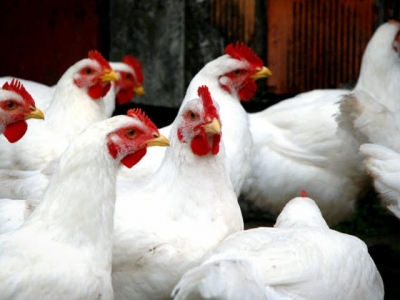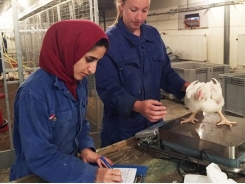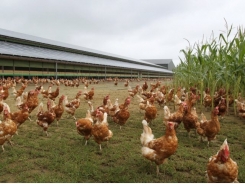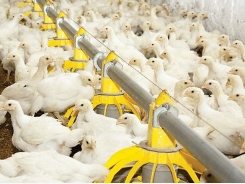Inclusion of DDGS in poultry diets

With about 70% of the cost of poultry production tied up in feed costs, there is a never ending quest for affordable feed ingredients. By-products from human food and also from other non-livestock production are a welcome source to explore. Dried distillers grains with solubles (DDGS) offer nutrients and energy, but should be included in poultry diets in moderate quantities.
The majority of by-products produced by the dry-grind ethanol industry are dried distillers grains with soluble. The DDGS from different sources like corn, rice, wheat, sorghum are highly useful for livestock and poultry. Among that corn DDGS is an excellent feed ingredient for use in layer, broiler, duck and turkey diets and contains approximately 85% of the energy value in corn, has moderate levels of protein and essential amino acids, and is high in available phosphorus.
Benefits of DDGS in poultry diets
With growing demand for food and scarce resources, the animal livestock industry doesn’t have the luxury of letting anything go to waste. Corn by-products (DDGS) from the ethanol industry are considered to be waste, but can still have a use as a feed ingredient. Because it is considered a waste product it is a very cheap source of crude protein, crude fibre, available phosphorous, unsaturated fatty acids and essential amino acids. Besides that it is an effective replacer of soya and corn in the poultry diet with the added benefit that it reduces feed costs by replacing soya in the diet as the price of soya is very high and often fluctuates. Replacing soya by DDGS is worth while, because it is a resource that will stay around for some time.
Enormous availability
Ethanol production is continually increasing and so the availability of DDGS will be enormous throughout the season.
In the poultry diet there are many advantages. Poultry fed with DDGS have a better feed intake, feed conversion ratio, body weight and body weight gain. And DDGS improves meat and egg quality by enriching it with omega-3 fatty acids (Linoleic acid) which is good for heart patients. Also, improved phosphorous bioavailability and therefore less phosphorous excretion prevents environmental pollution. Because of high phosphorous bioavailability, less exogenous phosphorous is supplemented and again it reduces the feed cost.
Feeding DDGS to chicken layers
The use of high quality corn DDGS in layer diets is an excellent partial replacement for corn, soybean meal and inorganic phosphate and supports excellent layer performance and egg quality. DDGS could be added to the diet of laying hens at levels of 10 to 20%, accounting for about 30% of the total dietary protein, without synthetic lysine supplementation, and has no effect on egg production or egg weight. Also an improvement in interior egg quality (Haugh units) was seen. Because of high xanthophylls in DDGS, egg yolk colour is improved. The oleic acid content decreased, and linoleic acid increased in egg yolk as increasing levels of DDGS were added to the diet, but the amount of saturated fatty acids in the yolk was not affected by DDGS supplementation. So feeding layer diets containing up to 15% DDGS did not affect production.
Feeding DDGS to broilers
Positive performance and better meat quality are the result when DDGS is added to broiler diets. The weight gain of broilers increased when small quantities of DDGS (2.5 and 5%) were added to the diet. DDGS can be added to broiler diets at levels up to 25% to achieve good performance if dietary energy level is held constant. High quality DDGS is an acceptable ingredient in broiler diets and a 6% maximum dietary inclusion rate in the starter period and 12 to 15% DDGS in grower and finisher phases of broiler production is recommended.
Potential constraints
Due to the use of sulphuric acid in the process, ethanol by-products may be high in sulphate which increases the risk of sulphur toxicity, when fed large amounts of distillers’ grain. A high concentration of H2S inhibits the oxidative processes in nerve tissue and results in central nervous system disorders. Besides that mycotoxins are a risk factor. Maize is susceptible to fungal infections producing mycotoxins. Due to the concentration that non-starch components undergo during the distillery process, mycotoxin concentrations are about three-fold in corn distillers’ grain compared to the original grain. It is thus of utmost importance that maize intended for bio-ethanol production is free of mycotoxins before processing. There are also ways to alleviate mycotoxin problems, such as removing damaged grains before they enter the process. Chemical treatments (NaOH, NH4OH, H2O2, NaCl, CH2OH) have to be performed to detoxify mycotoxins in stillage.
Copper
Certain traditional whisky distilleries use copper rather than stainless steel for stills and pipes, and their by-products tend to contain high levels of copper, which is toxic. Maize distillers’ dark grain, for instance, may contain between 15 and 120 mg/kg of copper. While copper content and biological copper availability are highly variable in whisky by-products, it is essential to check copper levels before buying such products. Copper is not an issue in industrial ethanol production.
Inclusion 15% or higher
At present, the recommended maximum dietary inclusion levels for corn DDGS are 15% for broilers, turkeys, layers, and ducks, but higher levels of corn DDGS can be used successfully with appropriate diet formulation adjustments for energy and amino acids. When formulating diets containing corn DDGS, digestible amino acid values should be used especially for lysine, methionine, cystine, and threonine. Diets should also be formulated by setting minimum acceptable levels for tryptophan and arginine due to the second limiting nature of these amino acids in corn DDGS protein.
The ever present mycotoxin problem can be mitigated by thorough examination before processing the corn. Copper and sulphur contamination is unavoidable in our processing technology and so the level of inclusion should be less in some areas. So in the future, the challenge is to prevent industrial contamination for safe usage of DDGS in poultry breeder rations.
Nutrient content and digestibility of Corn DDGS, High protein (HP)-DDGS

Có thể bạn quan tâm
Phần mềm

Phối trộn thức ăn chăn nuôi

Pha dung dịch thủy canh

Định mức cho tôm ăn

Phối trộn phân bón NPK

Xác định tỷ lệ tôm sống

Chuyển đổi đơn vị phân bón

Xác định công suất sục khí

Chuyển đổi đơn vị tôm

Tính diện tích nhà kính

Tính thể tích ao hồ




 Beware of cold temperatures affecting feed intake and…
Beware of cold temperatures affecting feed intake and…  How Much DDGS Can be Incorporated in a…
How Much DDGS Can be Incorporated in a…